One of my favorite things about reading books to my daughter is that, through the process of reading out loud, she learns so much about not just language, but also things like intonation, context, sarcasm, and all of those other glorious abstractions that come hand-in-hand with verbal communication. Funny books do a particularly good job of teaching children about those subtle underlying language rules, and I love watching my daughter realize on her own that, even though a character is seemingly saying one thing, you can infer through the context of the illustrations and the intonation of how the line might be read that the character actually MEANS something completely different. And, if you’re looking for an example of that kind of book, you can hardly do better than I Want My Hat Back by Jon Klassen.
Named as one of the New York Times best illustrated children’s books of 2011, I Want My Hat Back is a masterpiece of understated, slow-burn humor. Even Klassen’s illustrations revel in the art of the deadpan, giving us a menagerie of animal characters with stony, nearly unchanging faces. And yet the blank expressions of the animals – especially the face of the lead character, a bear – can suddenly convey volumes of emotion with only a slight shift of posture or eye position. Fun with language aside, this is a beautiful book – Klassen’s illustrative style reminds me of an exquisite hybrid of Frederick‘s Leo Leonni and A Sick Day for Amos McGee‘s Erin Stead.
And it’s a heck of a lot of fun to read too. The premise of I Want a Hat Back is gorgeously understated – there’s a bear who’s lost his hat and he wants it back. But, out of that set-up, Klassen creates an extremely funny scenario. Realizing that his hat is gone, the bear starts to ask other animals in the forest if they’ve seen his hat. He asks a fox and a frog, and they offer polite, repetitious responses, informing him that, “No. I have not seen any hats around here.” The bear then encounters a rabbit, who’s wearing a bright red pointy hat, the color of which starkly stands out against the muted earth-tone palette of all the other illustrations in the book. When asked about the hat, the rabbit responds:
No. Why are you asking me.
I haven’t seen it.
I haven’t seen any hats anywhere.
I would not steal a hat.
Don’t ask me any more questions.
And, no matter how obvious it is that he’s lying – talk about a self-incriminating witness – the bear doesn’t pick up on it, says “Thank you anyway”, and moves on to questioning a turtle.
As soon as I turned the page after the rabbit’s rambling response, my daughter did a brief double-take and said, “Wait… he totally stole that hat, didn’t he?” I gave a non-committal shrug and replied, “What do you think?”, and, suddenly, my daughter’s engagement with the story exponentially increased. She couldn’t believe that the bear hadn’t picked up on the rabbit’s obvious lie OR that the bear didn’t notice what was probably his own hat sitting on the rabbit’s head. Now my five-year-old had more information than the bear narrator and, enlivened by her discovery, she couldn’t wait to see how the mystery played out.
The bear asks three more animals for information regarding his hat and, during his questioning, my daughter got more and more excited and antsy about when the bear was going to realize his mistake. It’s only after a brief moment of self-doubt – the bear asks himself “What if I never see it again?” – and a conversation with a deer about what his hat looks like does the bear finally have an epiphany. And when we turned the page – revealing the bear sitting in front of a bright red background with the proclamation “I HAVE SEEN MY HAT” – my daughter squealed like she was watching a particularly engaging murder mystery and the detective had just found the smoking gun.
The bear runs back, past all of the other animals he interrogated, finds the rabbit, gets right in his face, and says, “YOU. YOU STOLE MY HAT.”
And this is where the book gets REALLY funny. This is the moment that every parent with a sense of humor will LOVE and that every child… well, you’ll have to see how your child responds. My daughter LOVED what came next. LOVED it. Basically, the bear is reunited with his hat and the rabbit is nowhere to be seen. And, when asked about the whereabouts of the rabbit, the bear responds in exactly the same way that the rabbit did, incriminating himself in the funniest way possible.
The ending of I Want My Hat Back has a wicked little sense of humor and, when we finished the story, my daughter got all wide-eyed and asked, “Does that mean…” Again, I just shrugged and she launched into a hilarious, stream-of-consciousness breakdown of what she thought happened, adding at the end, “Oh my god, that bear totally _______ and he’s LYING about it. I LOVE this book.” And she’s been talking about the ending since we first read the book this past weekend.
I Want My Hat Back seems like a very simple, direct book – a bear loses his hat, he looks for it, he gets it back. But there is an iceberg’s worth of hidden meaning lurking under the surface of each illustration and each piece of dialogue and watching a kid unlock those levels of meaning on their own is a really, really fun thing to witness.
Also, I think I Want My Hat Back functions as a great example of how to effectively build suspense in a children’s book. Alfred Hitchcock has a very famous quote about the difference between “surprise” and “suspense” that I think is totally applicable to Klassen’s book. In François Truffaut’s book Hitchcock, the great director commented that:
There is a distinct difference between “suspense” and “surprise,” and yet many pictures continually confuse the two. I’ll explain what I mean.
We are now having a very innocent little chat. Let’s suppose that there is a bomb underneath this table between us. Nothing happens, and then all of a sudden, “Boom!” There is an explosion. The public is surprised, but prior to this surprise, it has seen an absolutely ordinary scene, of no special consequence. Now, let us take a suspense situation. The bomb is underneath the table and the public knows it, probably because they have seen the anarchist place it there. The public is aware the bomb is going to explode at one o’clock and there is a clock in the decor. The public can see that it is a quarter to one. In these conditions, the same innocuous conversation becomes fascinating because the public is participating in the scene. The audience is longing to warn the characters on the screen: “You shouldn’t be talking about such trivial matters. There is a bomb beneath you and it is about to explode!”
In the first case we have given the public fifteen seconds of surprise at the moment of the explosion. In the second we have provided them with fifteen minutes of suspense. The conclusion is that whenever possible the public must be informed. Except when the surprise is a twist, that is, when the unexpected ending is, in itself, the highlight of the story.
In I Want My Hat Back, the red pointy hat is the bomb under the table. As the audience, we realize before the bear does that he missed his opportunity to get his hat back and Klassen expertly strings us along for several pages, watching the bear pointlessly continue on his quest, until the bear eventually catches up to us and, as readers, we collectively say “YES! FINALLY!” I can tell you that my daughter was barely able to contain herself once she realized the rabbit’s deception and, even though the suspense only lasted another 11 pages, it was enough to totally and completely suck her deeper into the book.
So, again, this is a simple book about a bear looking for his hat, but, within that premise, Klassen offers his readers a wealth of mystery, suspense, double-meanings, and some wonderful character comedy, which, it has to be said, is a very impressive achievement. Plus my daughter now has a new game where she replicates the rabbit’s style of lying – “No, I didn’t see any candy. I’ve never seen any candy. And I totally didn’t eat any candy.” – which is really, really funny to watch. So, thanks, Jon Klassen!
THE DETAILS ON I WANT MY HAT BACK
AGE RANGE: The stated age range is 4 and up, but the text is big enough and the illustrations are expressive enough that I think you could definitely read this to a much younger kid, provided that they’re OK with a subtle touch of black humor at the end.
PAGE COUNT: 40 pages
RELATED WEB SITES: You can find the official Random House site for I Want My Hat Back here, and Jon Klassen has a very cool, very minimalist website where you can find some more info on his work and career.
BUY IT, BORROW IT, OR FORGET IT?: I think this is a fantastic picture book that can also function as a very engaging early reader for developing readers. I’m really happy we bought it. However, if deadpan humor isn’t your thing or your kid’s thing, you might want to do a library trial before you purchase it for the home library.
IF YOU LIKED I WANT MY HAT BACK, YOU MIGHT ALSO LIKE:
- Children Make Terrible Pets by Peter Brown – Like I Want My Hat Back, Brown’s much sillier book also features a bear protagonist, but rather than struggling with something that’s lost, Brown’s bear struggles with something that’s found. Lucy, a young bear, finds a human boy in the woods and begs her mother to let her keep it as a pet. Despite her mother’s warnings, she embraces the boy as her own, until she quickly realizes that kids really do make terrible pets. Brown’s picture book doesn’t have the suspense of I Want My Hat Back, but it does feature a funny, insightful message about the dangers of trying to turn an undomesticated animal into a pet. (And what could be less domesticated than a young boy?)
- The True Story of the Three Little Pigs by Jon Scieszka and Lane Smith – This is another darkly funny, beautifully illustrated picture book that’s narrated by a furry predator, although Scieszka’s manipulative Wolf is much less sympathetic than Klassen’s wronged and determined Bear. While I Want My Hat Back does a masterful job of teaching kids the basic rules of suspense and reading between the lines, The True Story of the Three Little Pigs teaches kids all about unreliable narrators and, like in Klassen’s book, invites the readers to ask themselves if they really believe everything they’re being told.
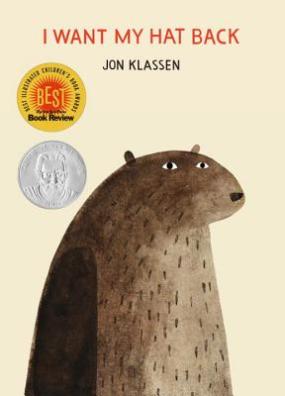
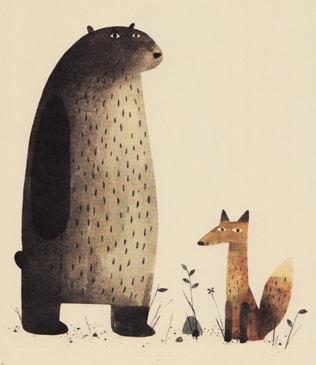
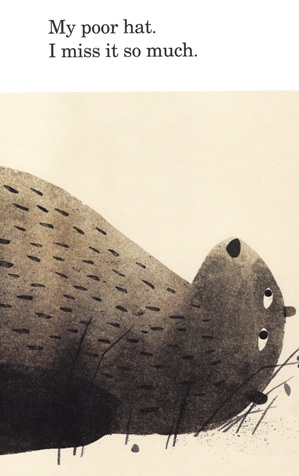
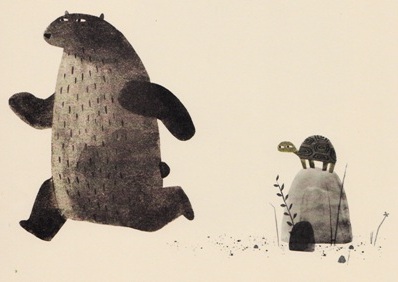
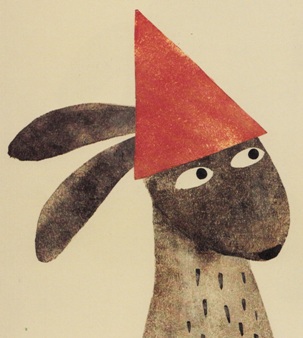
{ 2 comments… read them below or add one }
I found this book to be hilarious and very clever.
I’m pleased to see you praising “I Want My Hat Back”. There’s angry parents on Amazon and Goodreads that slam the book’s ending, using the old “the children will be corrupted” argument.
What?! Honestly. If you’re going to go round stealing other people’s hats, you deserve to be eaten.
My classes of EAL students (aged 6-8) love this book. They think the replies of all the different animals are hilarious, and see the poetic justice in the fate of the thieving rabbit.